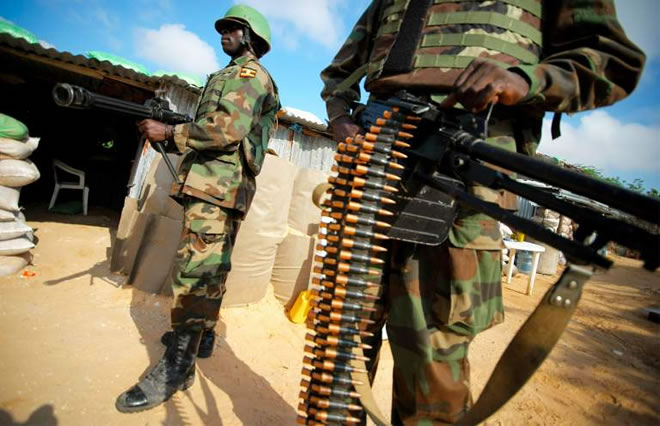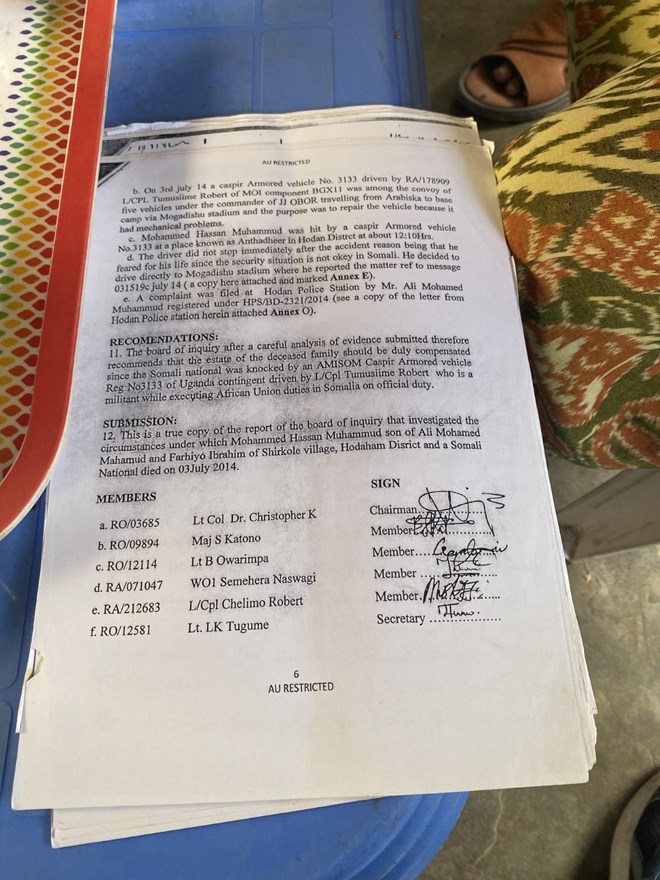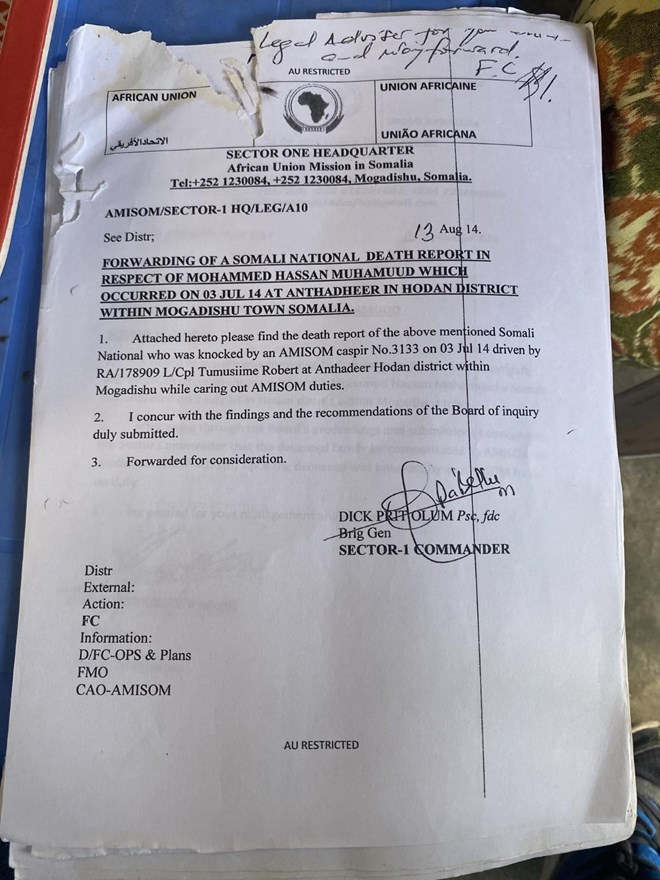Mohamed Gabobe explores several reports of extrajudicial killings by Western-backed forces in Somalia
Mohamed Gabobe
Saturday June 18, 2022
 An African Union Mission in Somalia (AMISOM) – Ugandan soldiers guard the frontline of the Yaaqshiid District. Photo: AMISOM / Alamy
An African Union Mission in Somalia (AMISOM) – Ugandan soldiers guard the frontline of the Yaaqshiid District. Photo: AMISOM / Alamy
After taking a motorbike ride from Mogadishu’s bustling Taleh junction to a dirt road on the outskirts of the Somali capital, where I trekked past a row of shanty homes, I caught my first glimpse of the elderly woman I was scheduled to meet. Standing before me with the warmest of smiles, she gestured towards her home, inviting me to enter.
She didn’t know much about me, only that I was eager to hear her story. She tells me her name is Sadiya, and that her family hails from the village of Buurane in the Middle Shabelle province, a region synonymous with militancy and where the rules of engagement are often non-existent.
When I offer a smile in the direction of three young children sitting on an old rug. she says, “These are my son’s children. They were left with me after he was murdered.”
Sadiya tells me how her 18-year-old son Sharmarke and his friends were cutting onions on the porch of her home, the day they were approached by coalition troops from Burundi serving under the UN-backed African Union Mission in Somalia, commonly referred to as AMISOM. The troops ordered the young men to go inside for reasons Sadiya doesn’t know.
AMISON soldiers routinely patrol the village of Buurane and its surrounding areas – often implementing curfews and detaining civilians under the mere pretext of suspicion. Many are often held under arbitrary detention for weeks – sometimes even longer.
On this occasion, however, the AMISOM troops departed without incident. Sadiya’s son and his friends went back to their chores, before starting a card game.
Moments later, a massive blast punctured the air, and a cloud of thick black smoke billowed into the night sky. A roadside bomb had struck a nearby AMISOM convoy.
Not long after that, AMISOM troops returned to her home. She remembers spotting one peering through the window seconds before they opened fire. Screams and falling glass engulfed the tiny home. Her son was cut down by a hail of bullets, piercing his heart and spine, and striking his friend sitting directly behind him.
The friend died instantly, but her son clung to life, screaming for his mother to stop the bleeding while mouthing the words to the Shahada (the Islamic declaration of faith).
The AMISOM troops barged into the home and pointed their weapons at Sadiya and her dying son, she says. Sadiya pleaded with the soldiers to allow her to tend to her son’s wounds, but to no avail. Her son bled to death in front of her eyes.
As Sadiya tells me this, she slumps to her knees, and sobs uncontrollably.
“It’s one thing to watch your child be shot in front of you. It’s another to watch them bleed out while begging for your help,” she says.
Sadiya’s account is consistent with testimonies of other eyewitnesses to mass killings carried out by AMISOM troops. A scathing report by Human Rights Watch revealed how AMISOM troops targeted wedding-goers near the Somali port town of Merka in 2015, killing six men, and denying medical care to the lone survivor, who later died of his wounds.
Sadiya said the soldiers remained in her home for two hours after her son bled out, leaving only when Somali Government troops arrived to retrieve the lifeless bodies of her son and his friend. Murdered at 18 years-of-age, Sharmarke would never get to see the arrival of his third child.
Moreover, in the weeks and months that followed, Sadiya endured relentless threats and intimidation from AMISOM troops, who would repeatedly show up at her home and order her to leave, she claims, often threatening to burn down her home if she continued to refuse their demands.
Sadiya says the AMISOM troops told her that they were carrying out military operations in the area and she needed to vacate the home, but this was an order given only to her, and nobody else in the village. The same troops that brutally murdered her son were now forcefully displacing her from the only home she’s ever known.
Many of her neighbours advised Sadiya to heed the warnings and not risk losing the three young grandchildren, but she refused to leave and instead pleaded her case to local authorities located several kilometres away in the district of Mahaadey.
But she was turned away.
Rampant Impunity
Coincidentally, the district of Mahaadey is home to a large-scale African Union military base that hosts foreign troops from Burundi. Sadiya believes her cries for help fell on deaf ears because coalition forces in Somalia wield immense influence over the local authorities, which explains why Somali officials often turn a blind eye to atrocities carried out by coalition forces from the African Union.
Deployed to Somalia in 2007 under the auspice of the United Nations Security Council, the AMISOM consists of thousands of foreign troops from nearly a dozen states in Africa, fighting under the rubric of the global ‘war on terror’, but without meaningful oversight or transparency.
Sadiya then made her way to the city of Jowhar, the provincial capital of the Middle Shabelle province and seat of power for Somalia’s semi-autonomous Hirshabelle state, turning up at the headquarters of the-then regional vice president, Ali Gudlaawe.
Again, she was turned away by Somali troops.
When the threats became too much to bear, Sadiya made the decision to flee Buurane. During the night, her brother-in law put Sadiya and her three grandchildren in a vehicle and sent them to the capital Mogadishu, where they remain to this day.
Two years have passed since the brutal murder of her son Sharmarke and his friend Abukar, but Sadiya is yet to receive any answers, let alone accountability from the UN-backed African Union Mission in Somalia.
After meeting Sadiya, I made my way to the notorious Suuqa-Hoolaha neighborhood in the Huriwa district of Mogadishu, which is a known to be an al-Shabaab stronghold. This isn’t an area that journalists often venture to.
There, I met Ibrahim, the father of Abukar, who was shot and killed in Sadiya’s home. Ibrahim fled the village of Buurane with his two remaining daughters immediately after his son’s murder. The trek to Mogadishu on foot took him and his children seven days. He’s never returned home since. Ibrahim wants justice for his family but knows that the prospects for accountability are slim.
Prosecuting African Union soldiers for atrocities in Somalia is nearly impossible, as the Somali Government has no jurisdiction over the multi-national coalition troops on their soil, which are funded by the European Union and supervised by the US and UK.
They are rarely, if ever, held accountable for the rampant war crimes and human rights abuses they are alleged to have committed.
The Case of Mohamed Hassan
During my investigation into war crimes by AMISOM troops in Somalia, the most perplexing case was the murder of Mohamed Hassan, a local university student from Mogadishu. He offers a typical example of how broken promises, deception and impunity make the death of a loved one at the hands of coalition forces even much more unbearable.
I arrived at the Tarabunka junction in Mogadishu, and stood in front of a mechanic shop, waiting for the go-ahead. A young woman dressed in all black wearing a Niqab (face veil) approached and told me to follow her.
I eventually found myself at the home of a prominent tribal chief – an older gentleman with a bright orange beard dyed in traditional colouring. I sat down at the table. What followed was the traditional Somali custom of drinking tea and getting acquainted with one another.
As we spoke, the tribal chief was eager to tell me about the ordeal of his family members who had been killed by AMISOM forces. When I began the interview, I couldn’t help but notice the armed gunmen in military attire standing a few meters away. The tribal chief told me not to worry; they were his people (clansmen).
He told me how his nephew, Mohamed Hassan, who he had raised from birth, was murdered by AMISOM forces in Mogadishu. “Mohamed was walking down a road in the Hodan district of Mogadishu, when he was struck by an AMISOM convoy, driving at full speed on 3 July 2014,” he said.
Mohamed died instantly from his wounds, as the AMISON convoy sped off. Ibrahim shows me a photo of his deceased nephew.

AMISOM military convoys in Somalia, particularly in the capital Mogadishu, routinely strike civilians while patrolling the city. Countless civilians have either been killed or wounded over the years, as has been widely reported in the Somali media.
The tribal chief said that he had reached out to his fellow clansmen, who held senior ranks in the Somali Armed Forces, to track down the AMISOM convoy responsible for his nephew’s death. It had made its way to Spartiva, they said, a football arena turned military base that housed foreign troops from the AMISOM coalition, but primarily from Uganda.
It was revealed that a Ugandan soldier by the name of Lance Corporal Tumusiime Robert was behind the wheel of the AMISOM truck that killed Mohamed Hassan. The soldier was detained and transferred to the fortified Halane compound (Somalia’s Green Zone) in Mogadishu, which houses numerous Western embassies, the United Nations headquarters, and the African Union Mission in Somalia (AMISOM).
But justice and accountability would not be forthcoming. “It was like running in circles,” the tribal chief told me.
They took up their case with the African Union, which responded by appointing a board of inquiry to investigate the murder, concluding that the family should be compensated, but the reparations never came.
“We were misled and deceived,” says the tribal chief.
The family were only ever given excuses. At times, the African Union would claim it was waiting on further confirmation from its headquarters in Addis Ababa. Other times it wouldn’t give an explanation, despite AMISOM’s own board of inquiry having agreed to compensate the family for Mohamed’s death.
“All we got at the end were documents from a Djiboutian official at AMISOM,” said the tribal chief, which he then shared with me.
The documents show a probe conducted by a six-member board from the African Union investigating the death of 20-year-old Mohamed Hassan at the hands of coalition troops.
The findings, as detailed in the documents, concluded that the AMISOM convoy was at fault in the death of Mohamed and therefore the family should be duly compensated.
The document shows the names of the military officials appointed to the board, as shown here:


Another document identifies the driver of the military convoy that killed Mohamed Hassan. The vehicle number is also stated on the document:

However, the tribal chief told me that they’ve almost given up hope on receiving any form of justice.
My the tribal chief’s revelations didn’t end there.
Pulling his seat closer, he told me that a relative named Omar Dhoore was extrajudicially murdered by AMISOM troops in volatile Lower Shabelle province on 1 September 2017, when Omar was tending to his crops in the farming village of Golweyn.
The tribal chief said that Omar was abducted by foreign troops from Uganda serving under the AMISOM coalition. He was taken to the town of Buula-Mareer, which hosts a large-scale Ugandan military base.
The tribal chief claims that he led a group of local elders there, pleading for the release of Omar, only to have their request rebuffed.
Days later, however, locals discovered Omar lifeless on the side of a dirt road that connects the town of Buula-Mareer to the village of Golweyn – bullet holes riddling his body.
Both of Omar’s hands and eyes were tied shut. The brunt of the bullet holes was across his face and head. The tribal chief showed me a photo of Omar’s body, claiming it demonstrates evidence of extrajudicial murder.
 A photo of Omar Dhoore following the discovery of his body
A photo of Omar Dhoore following the discovery of his body
International Culpability
Over the years, AMISOM troops have been implicated in numerous extrajudicial killings and wanton massacres of civilians. The abduction and brutal execution-style murder of Omar Dhoore has eerie similarities with other cases of enforced disappearances and extrajudicial killings. Most notably, the 2021 Golweyn Massacre, which saw seven civilians abducted and murdered.
When the tribal chief and local elders went to the AMISOM base in Golweyn, demanding to know how someone in their custody could be later found dead on a dirt road, the Ugandan military commanders openly acknowledged that Omar was killed in “retaliation” for a recent attack carried out by the terror group al-Shabaab in the area, causing the deaths of several Ugandan soldiers.
In disbelief, the tribal chief led his fellow elders to the fortified Halane compound (Somalia’s Green Zone) in Mogadishu, where they held a closed-door meeting with Ugandan military officials.
During the encounter, the Ugandan officers from AMISOM admitted wrongdoing and stated that they would compensate the victim’s family to the tune of $3,000 – but that soon turned out to be another false promise.
“They’ll make you promises for accountability and compensation, then have you keep going back and forth, running until you get tired and just simply stop coming back,” the tribal chief said.
To this day, they’ve heard nothing further about the compensation. Five years have now passed since Omar was murdered.
“He had no affiliation with the insurgents. He didn’t deserve to die,” the tribal chief said.
AMISOM has a mandate to fight the armed group al-Shabaab and prop up Somalia’s fragile government. but as of 31 March of this year, the UN Security Council (UNSC) unanimously adopted resolution 2628, which states that AMISOM will transition into the African Union Transition Mission in Somalia (ATMIS) and will oversee the withdrawal of multi-national coalition forces from Somalia by December 2024.
While this move is welcomed by the people of Somalia, it offers little comfort to the families whose lives have been wrecked by these forces.
Prominent international human rights organisations have directly implicated AMISOM troops in the deliberate targeting of civilians by indiscriminately shelling densely populated urban areas under the pretext of fighting militants, particularly during the siege of Mogadishu, which spanned from January 2009 to August 2011.
Similar reports released by human rights bodies have accused AMISOM forces of using rape as a weapon of war against both women and young children.
To that end, Western governments that continue to finance, supervise and provide cover for AMISOM bear part of the responsibility. Indeed, the continued presence of foreign troops in Somalia is a direct result of decisions made in Washington, Brussels and London.
If calls for accountability continue to be brushed aside by the so-called ‘international community’, then Somalia will be remembered as another terrible example of how Western-sponsored foreign military interventions, often under the guise of counter-terrorism and peacekeeping, cause more harm than good.